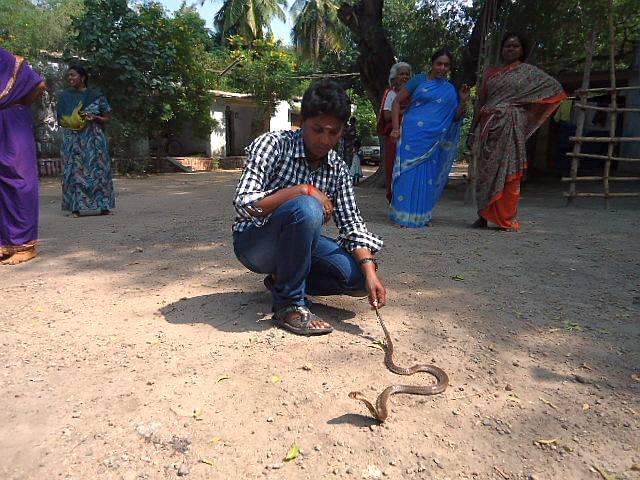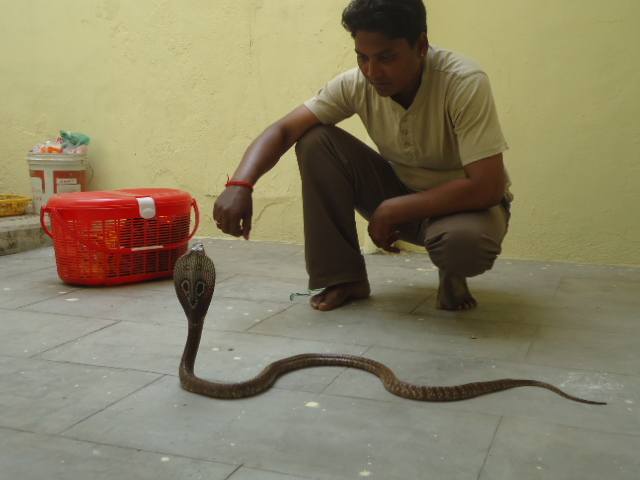A Ganesh Nadar
P Manimegalai catches snakes in the city of Madurai and releases them in the forest.
Her love for animals is obvious. She has a squirrel which sleeps on her arm when she goes to bed.
She yells at mahouts when they use their elephants to beg. She fights with poachers when they shoot rabbits.
Twenty-eight-year-old Manimegalai is founder member of the Tamil Nadu Snake Research and Wild Animal Rescue Trust along with R Nagarathinam, M Selvakumari, Katheejal Begum and S Amutha. They work with a team of seven women.
Why only women?
"Men start with enthusiasm but never continue; their long term commitment is nil," Manimegalai said, not mincing her words.
She chooses to stay in Madurai as her native district of Ramanathapuram is a dry area and there are very few snakes.
She had also read that snakes were being spotted and killed regularly in Madurai.
Once she starts talking about animals, and particularly snakes, there is no stopping her.
Please click NEXT to continue reading...
Why snake-catching became important
Image: P Manimegalai catches a snake in a Madurai villageAs a kid I used to like hunting. One day my father scolded me, 'You should be protecting animals. They can't speak for themselves and you are killing them'.
I immediately stopped my hunting activities. I loved animals and used to go looking for them.
Snakes are the most endangered species of all because the minute anyone sees them, they want to kill them.
Once I saw boys throwing stones at a cobra on the road. I stopped them and rescued the cobra, took it to the veterinarian who treated it for a week. It recovered and I released it in the forest.
Creating awareness
There are 65 species of snakes in Tamil Nadu and only four are poisonous, but people kill every snake they come across.
The poisonous snakes have teeth; the others don't. I conduct snake awareness campaigns on the street and in colleges. To teach people that all snakes are not dangerous and that a snake is actually more scared of them.
Snakes do not have ears. They know what is happening in their surroundings by sight and also they can feel vibrations of movement.
So if you sit quietly when you see a snake, it will go away once it feels safe and sure that you are not going to attack it.
I once caught a snake in the ESI hospital here. After catching it I told the women there that it was not dangerous. I made them touch it. After that they stopped being scared.
Please click NEXT to continue reading
'Snake Mani'
Image: P Manimegalai catches a snake in a house in MaduraiThough my name is Manimegalai, in Madurai they call me 'Snake Mani'.
People call me when a snake enters their home or office. Since January this year I have caught 150 snakes and released them in the jungle.
One night I had gone late into the forest to release a snake. I saw poachers shooting rabbits. I shouted at them and they ran away leaving the dead rabbits. I photographed the dead rabbits and gave it to the forest rangers. They did not take any action.
Most snake catchers use a stick to catch them. I don’t, because when you press the stick, the snake’s back bone breaks and it dies within a week.
I use my hands.
I don't charge for catching snakes but people pay me as they are so relieved to see the snake leave their home.
I support myself by selling artificial jewellery to women. I also bring dry fish from Mandapam and Ramanathapuram, clean it and then re-pack it in plastic bags and sell it house to house.
Education
My father Pushpanathan and my family are in Ramanathapuram. I stay in a rented house here.
I studied till Class 10 standard only. I have been catching snakes for the last five years.
I could not continue studying because of poverty. There are four girls and two boys in my family and my father was a labourer.
I have lost touch with education and cannot go back to study and have no intention of doing so.
I read a lot so I have a lot of general knowledge. I don’t think that the lack of formal education has hurt me or hindered me in any way in life.
I have learnt everything about snakes from Sadiq Basha who runs an NGO called Tamil Nadu Green Movement and Jayachandran of Tamil Nadu Snake Movement.
My aim in life is to save as many snakes as possible.
Please click NEXT to continue reading...
How to identify a poisonous snake
Image: P Manimegalai also fights against cruelty to elephantsI have been bitten by non-poisonous snakes many times. In fact, I sometimes let the snake bite me in public so that people realise that it’s not fatal.
But I am very careful when dealing with poisonous snakes.
There are only four poisonous snakes in my area: cobra, king cobra, viper and rattlesnake, and you should know them by sight.
There is no method of identifying poisonous or non-poisonous snakes from a distance. You just have to know the four that are dangerous.
If a snake comes into your office or home or you see it in your path just be silent and don't move.
Snakes can catch movement so don’t move. Once it realises that you are not a danger it will move away.
Also, most snakes only come out at night as they cannot stand heat. They come out to eat rats and frogs. They can smell with their tongue.
Gender issues
Women snake catchers are respected. We don’t face any challenges or hindrance because of our gender. In fact, every time I catch a snake, the appreciation is more because I am a woman. The appreciation is encouraging.
My fellow founder trustees who are also expert snake catchers are Vijaylakshmi who is a government staff nurse, and Selvakumari who is a graduate and warden of a ladies hostel in Coimbatore.
Those interested in working for animal welfare need to be sympathetic to animals.
More important, you have to empathise with them. You should know when they are hungry, when they are in pain, when they need to sleep and when they need to be left alone.
Whenever I see an elephant chained in a temple I always fight with the temple people.
"Which God told you to put chains on the elephant, see his legs, there are wounds where the chain has bitten into his skin," I tell them, but to no avail.





Comment
article